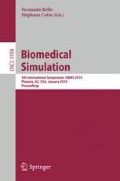Abstract
With 30 million interventions a year worldwide, cataract surgery is one of the most frequently performed procedures. Yet, no tool currently allows teaching all steps of the procedure without putting patients at risk. A particularly challenging stage of this surgery deals with the injection and deployment of the intra-ocular lens implant. In this paper we propose to rely on shell theory to accurately describe the complex deformations of the implant. Our approach extends the co-rotational method used in finite element analysis of in-plane deformations to incorporate a bending energy. This results in a relatively simple and computationally efficient approach which was applied to the simulation of the lens deployment. This simulation also accounts for the complex contacts that take place during the injection phase.
Access this chapter
Tax calculation will be finalised at checkout
Purchases are for personal use only
Preview
Unable to display preview. Download preview PDF.
References
Feudner, E., Engel, C., Neuhann, I., Petermeie, K., Bartz-Schmidt, K., Szurman, P.: Virtual reality training improves wet-lab performance of capsulorhexis: results of a randomized study. Graefes. Arch. Clin. Exp. Ophthalmol. 247, 955–963 (2009)
Liu, G., Quek, S.: Finite Element Method: A Practical Course. Butterworth (2003)
Provot, X.: Deformation constraints in a mass-spring model to describe rigid cloth behavior. In: Graphics Interface 1995, pp. 147–154 (1995)
Hammer, P.E., Perrinb, D.P., del Nidob, P.J., Howe, R.D.: Image-based mass-spring model of mitral valve closure for surgical planning. In: Proc. of SPIE Medical Imaging, vol. 6918 (2008)
Yu, H., Geng, Z.: An improved mass-spring model to simulate draping cloth. In: IEEE International Conference on Intelligent Computation Technology and Automation, vol. 1, pp. 568–571 (2008)
Taskiran, H.D., Güdükbay, U.: Physically-based simulation of hair strips in real-time. In: WSCG (Short Papers), pp. 153–156 (2005)
Wang, F., Duratti, L., Samur, E., Spaelter, U., Bleuler, H.: A Computer-Based Real-Time Simulation of Interventional Radiology. In: The 29th Annual International Conference of the IEEE Engineering in Medicine and Biology Society (IEEE-EMBS), pp. 1742–1745 (2007)
Choi, M.G., Woo, S.Y., Ko, H.S.: Real-time simulation of thin shells. In: ACM SIGGRAPH/Eurographics symposium on Computer animation, pp. 349–354 (2007)
Bridson, R., Marino, S., Fedkiw, R.: Simulation of clothing with folds and wrinkles. In: Symposium on Computer Animation, pp. 28–36 (2003)
Grinspun, E., Hirani, A.N., Desbrun, M., Schröder, P.: Discrete shells. In: Proceedings of the Symposium on Computer Animation, pp. 62–67 (2003)
Wicke, M., Steinemann, D., Gross, M.: Efficient animation of point-sampled thin shells. In: Computer Graphics Forum (Eurographics 2005), vol. 24, pp. 667–676 (2005)
Thomaszewski, B., Wacker, M., Strasser, W.: A consistent bending model for cloth simulation with corotational subdivision finite elements. In: ACM SIGGRAPH/Eurographics Symposium on Computer Animation, pp. 107–116 (2006)
Felippa, C.A.: A systematic approach to the element independent corotational dynamics of finite elements. Technical Report CU-CAS-00-03, Center for Aerospace Structures (2000)
Muller, M., Gross, M.: Interactive virtual materials. In: Proceedings of Graphics Interface (GI 2004), pp. 239–246 (2004)
Przemieniecki, J.: Theory of matrix structural analysis. McGraw-Hill, New York (1985)
Allard, J., Cotin, S., Faure, F., Bensoussan, P.J., Poyer, F., Duriez, C., Delingette, H., Grisoni, L.: Sofa - an open source framework for medical simulation. In: Medicine Meets Virtual Reality, pp. 13–18 (2007)
Zhongnian, X.: A simple and efficient triangular fem for plate bending. Acta Mechanica Sinica 2(2), 185–192 (1986)
Saupin, G., Duriez, C., Cotin, S., Grisoni, L.: Efficient contact modeling using compliance warping. In: Proceedings of Computer Graphics International Conference (2008)
Author information
Authors and Affiliations
Editor information
Editors and Affiliations
Rights and permissions
Copyright information
© 2010 Springer-Verlag Berlin Heidelberg
About this paper
Cite this paper
Comas, O., Cotin, S., Duriez, C. (2010). A Shell Model for Real-Time Simulation of Intra-ocular Implant Deployment. In: Bello, F., Cotin, S. (eds) Biomedical Simulation. ISBMS 2010. Lecture Notes in Computer Science, vol 5958. Springer, Berlin, Heidelberg. https://doi.org/10.1007/978-3-642-11615-5_17
Download citation
DOI: https://doi.org/10.1007/978-3-642-11615-5_17
Publisher Name: Springer, Berlin, Heidelberg
Print ISBN: 978-3-642-11614-8
Online ISBN: 978-3-642-11615-5
eBook Packages: Computer ScienceComputer Science (R0)

